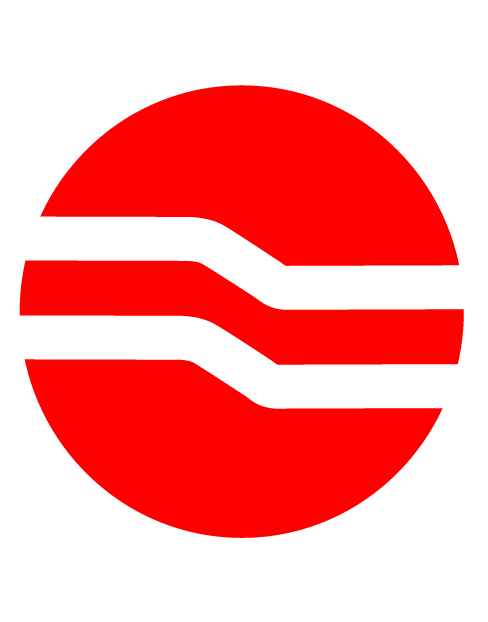 |
 |
Japan Karate Do Hakua-Kai Matsubushi Dojo |
|
|
|
|
 |
| TOMARI-TE |
 |
|
Tomari-te (泊手 Okinawan: Tumai-dii) refers to a tradition of martial arts originating from the village of
Tomari, Okinawa. Based on an underground empty-handed fighting style native
to Okinawa, Tomari-te arose largely through the influence of Chinese diplomats
and other personages skilled in Quan fa, such as Wang Ji, Anan, and Ason,
in the late 17th century. Along with Naha-te and Shuri-te, Tomari-te belongs
to a family of martial arts that were collectively defined as Tode-jutsu
or To-de
Tomari-te is not a school or a style, but a tradition where the old Okinawa
Tode-jutsu is preserved. In the Shoreijikan Association, Tomari-te from
the Oyadomari family – Nakaema Seikichi (from Nago, Okinawa) has been preserved
and recently it was founded the Zen Minami Hankyo Okinawa Tomarite Koukai
to preserve the Nakaema-ha,
The most famous Tomari-te masters were both the chikudon peichin Kosaku Matsumora (1829-1898), Kokan Oyadomari (1827-1905), Gikei Yamazato (1835-1905), Choki Motobu (1870-1944) and Chotoku Kyan (1870-1945). They were also disciples of the Chinese Annan (also Ahnan or Anan) and of Ason, a Chinese sergeant. According Tomari-te tradition, Annan was a castaway from a shipwreck in the Okinawa coast. Being a pirate, he that took refuge in the cemetery of the Tomari's mountains, starting to live in a cave (a tradition says that this was the master that taught the kata Chinto to Sokon Matsumura). Matsumora and Oyadomari were also disciples from two local masters, Kishin Teruya (1804-1864) and Giko Uku (1800-1850). From Teruya they would learn Passai, Rohai, and Wanshu, and with Uku the kata Naifanchi. According Shoshin Nagamine (in "Tales of Okinawa's Great Masters", Tuttle Pub, Boston, 2000), Teruya was considered by Matsumora as his true master. Matsumora was also an expert in Jo-jutsu (fight method with a short staff) from Jigen-ryu.
|
|
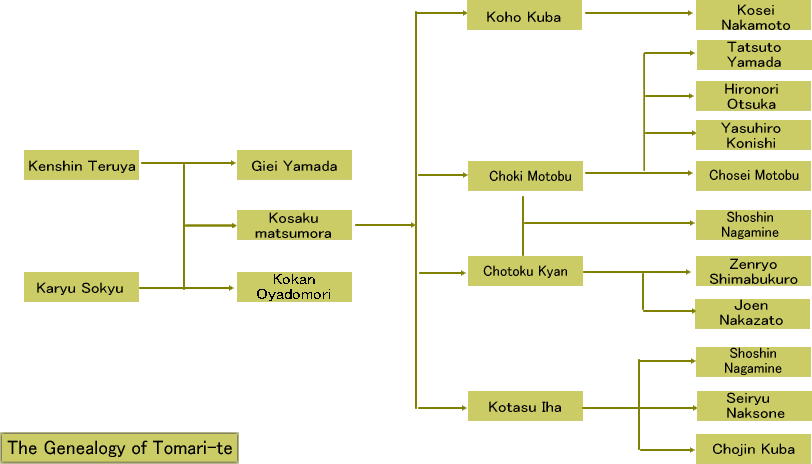
|
|
|
The lineage of the Tomari-te
The masters of the Tomari-te best known in the century XIX was Kosaku Matsumora,
Kokan Oyadomari and Gikei Yamazato or(Giei Yamada).
From these thre great masters from Tomarite, the following masters generation
was formed: Nio Sueyoshi (1846-1920), Kinin Kinjo (1856-1897), Giki Yamazato
(1866-1947, son of Gikei), Seikichi Nakaema (1866-1932), Koho Kuba (1870-1942),
Kamado Higa (1871-1930) and Kotatsu Iha (1873-1928). Kosei Nakamoto (1890-1967)
was the Koho Kuba successor. From Kotatsu Iha, were formed the following
sucessors: Seiyu Nakasone (1893-1967), Gisei Maeda (1899-1983), Kosei Iha
(1891-1967), Koko Oyadomari (1882-1908), Seijin “One-Eyed” Toguchi (1895-1937),
Chojin Kuba (1904-1989), Shoshin Nagamine (1906-). Seikichi Nakaema sucessor
was his brother and from this his son, Moritoshi Nakaema, l Nakaema family
is from Nago, Okinawa.
Oyadomari Kokan
karate was preserved by his two sons, Kotsu and Konin, and Seikichi Hokama was
disciple of both. The name of Chotoku Kyan and Motobu Choki are also associated
to Tomari-te tradition, as also the name of Shimabukuro Tatsuo. This later and
Soshin Nagamine, have trained also with Motobu. Seyu Nakasone, disciple of Iha,
was the master of Tokashiki Iken (founder of Gohakukai), Nakamoto Seiko, Fukichi
Isao and Hokama Tetsuhiro. Tokashiki Iken teaches what he was taught by
Nakasone, the katas Naifanchi I, II, III, Passai, Wankan, Wanshu Dai and Sho,
Rohai, Kusanku, Chinto and Rinkan. This later kata was a creation of Nakasone to
be his personal kata (Mario McKenna, personal communication). Although the
Naifanchi series, Passai, Kusanku and Chinto taught by Nakasone be similar to
the Oyadomari equivalent katas, the Nakasone’s Wankan, Wansu and Rohai resembles
Goju style and techniques. Nakasone trained with Higa Seiko (they were friends).
The successor styles to Tomari-te include Motobu-ryū, Matsubayashi-ryu,
Shōrinji-ryū, Gohaku-Kai and Matsumora-ryū Kōtokukai,Nihon
|
|
|
|
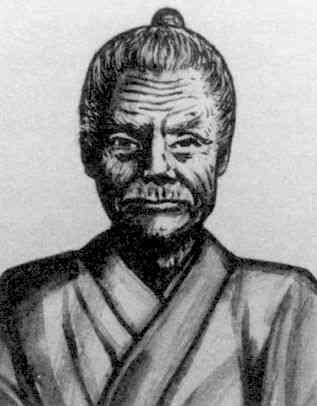
Matsumora Kosaku
1829-1898 |
 |
Kosaku Matsumora (松茂良 興作)
Matsumora Kōsaku (1829 - 1898) (Matsumora Chikudon Peichin Kosaku) was a prominent bushi from the west
side of Tomari village. His family were indirect descendents of the first
Sho king. As a boy, he studied Chinese classics and Confucianism at the
Tomari School for young men from families of position. Matsumora was short
in height, but his wide shoulders and massive chest revealed a muscular
body.
Matsumora studied Karatedo from Karyu Uku (Aka Giko Uku) for 3 years, emphasis was on developing a strong foundation while learning to use his legs for mobility and hips to generate power. Master Uku taught Matsumora three Kata known in Tomari as Naihanchi.
Matsumora then studied with Teruya Kishin.He also studiedJigen-ryu. He learned the Katas Passai and Wanshu from this great master. Master Teruya was so impressed with this young bushi that he invited Matsumora to continue his training at the family tomb. This was the greatest honour that the young man could receive, because at this time the study of Karate was still practiced in total secrecy, and very late a night. Being caught at practice meant certain death. |
It was at the family tomb that Teruya revealed bunkai or application training to Matsumora so that he could understand the deeper meaning of the kata movements and the practical application of the moves.Among Matsumora's students, who went on to influence new generations through
students of their own, were Choki Motobu and Chotoku KyanMatsumora is credited
as the master who taught Chotoku Kyan the kata Chinto (his own version,
not to be confused with Sokon Matsumura's version of the same kata). Another
student of Matsumora, Maeda Pechin, is credited with teaching Kyan the
kata Wanshu.
When Matsumora was in his early 20's, he successfully defended himself
and several townspeople against a Satsuma swordsman. Matsumora disarmed
the swordsman and threw the sword in the river, losing only his little
finger in the encounter. Losing one's sword in battle was, for any samurai,
a loss of spirit. However for a samurai of the fierce Satsuma clan to lose
his sword to an Okinawan was an unimaginable disgrace.The official story comes from Nagamine. The event was so insulting to the hated Japanese overlords that Matsumora became an Okinawan folk hero overnight.
Losing a finger however made Matsumora a marked man. Fortunately, the whole
town of Tomari came to his rescue by hiding his were-abouts from the retaliating
government officials. Matsumora went into hiding/seclusion in the Nago
area.Matsumora was also a master of Bo-jutsu, the study of the 6 foot wooden
staff, and Jo-jutsu the 4 foot stick, despite his "handicap".
Matsumora Kosaku is well remembered for fighting injustices brought on
all Okinawan's by the Meiji Government. He is credited with saving the
Neewagumuchi, an Endowment to the people of Tomari from the scavenging
officials.
His relentless battles against injustices during the Japanese take-over
earned him the name "Fist Saint". |
|
|
|
Kokan Oyadomari (親泊 興寛)
Kokan Oyadomari (1827-1905) was a disciple of the Chinese Annan (also Ahnan
or Anan) and of Ason, a Chinese sailor or possibly a pirate. Annan was
a castaway from a shipwreck along the coast of Okinawa, who took refuge
in the cemetery of the mountains near Tomari. There is a legend which indicates
that Annan was the master who taught the kata Chinto to Sokon Matsumura.
Oyadomari was also a disciple to two local masters: Kishin Teruya (1804-1864)
and Giko Uku (1800-1850). From Teruya, Oyadomari learned Passai, Rohai,
and Wanshu, and from Uku the kata Naifanchi. According Shoshin Nagamine
(see "Tales of Okinawa's Great Masters", Tuttle Pub, Boston,
2000), Teruya was considered by Matsumora as his true master.
|
|
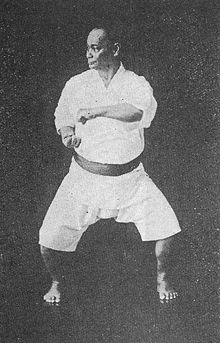 |
Choki Motobu
Choki Motobu was born in 1871 in Akahira village in the Shuri region of
Okinawa. He was the third son of Motobu "Udun", a high ranking
aji or lord. The Motobu family were skilled at the art of Ti (a grappling
art of the Okinawan nobility). Motobu did learn some of the techniques
of his family's fighting system, but because of Okinawan tradition, only
the first son, Choyu, was educated and choose to carry on the family's
martial tradition.
Because of this situation, he went looking for instruction elsewhere. Choki began training extensively with makiwara and lifted heavy rocks to gain strength. He endeavored to become as strong as possible and trained with ferocity. He became known as "Motobu zaru" or Motobu the monkey because of his agility and speed.
Eventually, Motobu became the student of Anko Itosu (one of Mabuni's sensei). Now a young man, Choki spent a lot of time seeking out strong looking men to challenge on the street. He won most of his fights and learned much from these encounters. Itosu sensei was not impressed by the young man's bullying and promptly expelled him form the dojo.
Motobu's aggressive behavior soon earned him a bad reputation and many sensei would not teach him. Once man, however, liked the spirit he showed and accepeted him as a student of karate. This man was Kosaku Matsumura of Tomari. It was from Matsumura that Choki learned many Kata. Motobu still challenged others to fights often and was eager to develop and improve his fighting skills. |
He eventually asked Matsumura to teach him kumite, but Matsumura told
him to continue to learn on his own. Motobu, however, was persevering and
is said to have watched the kumite training through holes in the fence
around Matsumura's dojo.Motobu's street fighting served him well (to the
detriment of many). He formulated his own formidable style of kumite and
began to get much attention in Okinawa and in Japan on his trips to the
islands. One day while in Kyoto he witnessed a contest where people were
asked to match skills with a foreign boxer. A friend coaxed Motobu to give
it a try.
The boxer was arrogant and goaded Motobu constantly. For two rounds Motobu just avoided the boxer's attacks. In the third round he had enough. He used a practiced technique and promptly knocked the boxer out. The crowd was quite taken aback. They had never seen this kind of fighting. Motobu had simply struck his opponent with a fore knuckle in the temple; a basic technique. Needless to say, Motobu quickly gained a reputation as a master and many curious people came to learn this mysterious new art. Soon, Motobu became a full time teacher.
During this time, Motobu gained great respect for his fighting ability. He was hailed as the greatest fighter in Japan. Many sensei advised their students to go and train with Motobu and learn his kumite techniques ( for obvious reasons). He was also asked to teach at several universities. Because of this, many of today's great instructors of various styles had the benefit of his instruction, so it is clear that his was a large influence in karate.
Motobu usually only taught naihanchi kata to his students and it was his own version with many Ti-like grappling and throwing techniques. However, it was his kumite that had the greatest impact on karate. Oddly enough, there is a story of Choki, full of confidence, challenging his brother Choyu to a fight. It is said that Choyu threw Choki around like a rag doll. After the experience, Choki is said to have humbled himself and adopted more of his family's Ti forms.
Later in life, Motobu seemed to stress the importance of tradition in training. He strongly stressed the importance of makiwara training and became as enthusiastic about kata as he had always been about kumite. In 1936, at the age of 65, Motobu left Tokyo and went back to Okinawa to visit his instructors to talk about the state of karate in Japan and to make sure that he was teaching the kata and techniques in their originally, unaltered form. Subsequently, he returned and continued teaching in Tokyo.
Shortly before World War II, he returned to Okinawa and died in September of 1944 of a stomach disease at the age of 73. It is obvious that Choki Motobu was very instrumental in the development of karate and that he was the inspiration for many who trained in the art. It is good to see that, today, millions of people still keep the art alive and strive to keep the fighting spirit of karate which Sensei Motobu so dearly loved.
|
|
|
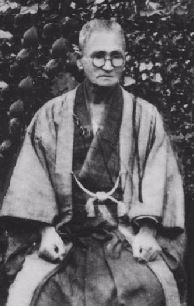 |
Chotoku Kyan
Chotoku Kyan was born in Shuri, Okinawa in December 1870 and was the first son of Chofu Kyan. Chofu Kyan had been a descendant of the fourth Ryukyuan king, Shoshi. Kyan (also sometimes pronounced Kiyuabu) was born a frail child, but through his martial arts training he developed into a strong adult and his health improved much. He had begun his training in karate-do at the age of five years old.
Kyan was known in Okinawa as 'Chan mig-wa' or 'small-eyed Kyan',
and was known by this nickname because his eyes were small and weak. Despite
this handicap, he went on to become a great master. In fact, he was one of the
most knowledgeable masters of his time, as he studied both the Shuri-te and the
Tomari-te styles of karate.
He studied Shuri-te from Sokon Matsumura and Anko Itosu and
studied Tomari-te from Oyadomari Pechin, Maeda Pechin and
Kosaku Matsumora. Kyan's teaching combined the elements of both of these styles
of karate, with his students originally calling his system 'migwa-te', but later
it became known as 'Sukunaihayashi-ryu'.
Kyan enjoyed traveling a good deal. During his martial arts
career he journeyed to Taiwan, where he brought back the kata Ananku to Okinawa.
He also visited one of Okinawa's off-lying islands and learned Tokumine no Kun
(bo kata) there. Tokumine Pechin had been a lord in Okinawan, but had
been banished to the Yaeyama Islands after having being involved in a fight with
30 constables in the red-light district.
|
|
Chotoku Kyan lived in Shuri until he was about thirty years old and then he moved to Kadena, where he opened his own dojo. He lived in the village of Yomitan, where a karate man called Yara taught him the Kusanku kata. In addition to Kusanku kata (which became his favorite), he learned other kata; from Sokon Matsumura he learned Naihanchi and Gojushiho, from Kosaku Matsumura he learned Seisan, Oyadomari taught him Passai and Maeda Pechin taught him Wanshu. Kyan later developed his own versions of the katas Chinto and Passai, and he even learned tree fighting which is linked to the Okinawan monkey dance 'saru mari'.
Because of his reputation, Kyan was often challenged. It is alleged that he fought many actual fights but was never defeated. Kyan was highly adept at body shifting. Since he was a small man, he used this type of body movement (known as tai sabaki) to defeat his opponent. His technique was to never back up, but rather to move forward rapidly and strike, or block and counter attack immediately.
Two of Chotoku Kyan's top students were Ankichi Arakaki and Shimabuku and it is said that they accompanied their teacher almost everywhere and were inseparable from him. Kyan enjoyed rooster fighting very much, in fact he often entered his own roosters in these fights.
One anecdote reveals something of Kyan's abilities as a martial artist, by telling that on this particular occasion he attended one of these rooster fights and had his own rooster in a firm grip under his arm. His students, Arakaki and Shimabuku, decided to test their masters skill and started a fight with a couple of the local men. Once the fight got started they left and hide in some nearby bushes. When Kyan came over to see what was happening, and to see where Arakaki and Shimabuku were, the enraged men attacked him. Kyan is said to have fought with the men and defeated them all. What was so unique about this occasion was that during the entire fight, Kyan had kept a firm hold on his rooster - he fought them all with only one hand and his feet. Arakaki and Shimabuku watched the whole fight from their hiding place and were amazed by his skill and composure.
Kyan felt strongly about the ancient code of Bushido and felt that every martial artist should follow it totally. He was both a perfectionist and a disciplinarian, in both his own training and also his teaching. He believed that self-discipline and social order and justice went hand in hand.
He was also quoted as saying "superior conditioning can only be built on relentless effort. The size of one's body is irrelevant".
Master Chotoku Kyan died Ishikawa City, Okinawa, on 20th September 1945 - he was 76 years old.
|
|
|
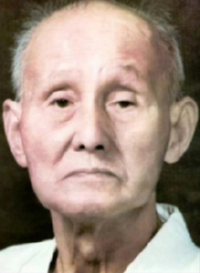 |
|
Hironori Ōtsuka (大塚 博紀)
Hironori Ōtsuka(大塚 博紀, Ōtsuka Hironori, June 1, 1892 – January 29,
1982)was a Japanese master of karate who created the Wadō-ryū style of karate.He
was the first Grand Master of Wadō-ryū karate, and received high awards
within Japan for his contributions to karate.
Ōtsuka was born on June 1, 1892, in Shimodate City, Ibaraki, Japan.He was one of four children to Tokujiro Ōtsuka, a medical doctor.At the
age of 5 years, he began training in the martial art of jujutsu under his
great-uncle, Chojiro Ebashi (a samurai).Ōtsuka's father took over his martial arts education in 1897.At the age
of 13, Ōtsuka became the student of Shinzaburo Nakayama in Shindō Yōshin-ryū
jujutsu.
|
|
On June 1, 1921, Ōtsuka received the menkyo kaiden (certificate of mastery
and license to teach) in Shindō Yōshin-ryū jujutsu, and became the fourth
master of that school.Jujutsu was not to become his primary art, however;
in 1922, Ōtsuka began training in Shotoka karate under Gichin Funakoshi
who was a new arrival in Japan.In 1927, he also established a medical practice and specialized in treating martial arts training injuries. By 1928, Ōtsuka was an assistant instructor in Funakoshi's school. He also trained under Chōki Motobu and Kenwa Mabuni, and studied kobudo, around this time.Ōtsuka began to have philosophical disagreements with Funakoshi,and the two men parted ways in the early 1930s.This may have come, in part, from his decision to train with Motobu. Funakoshi's karate emphasized kata, a series of movements and techniques linked by the fighting principles. Funakoshi did not believe that sparring was necessary for realistic training. Motobu, however, emphasized the necessity of free application, and created a series of two-person kumite called yakusoku kumite.
|
|
|
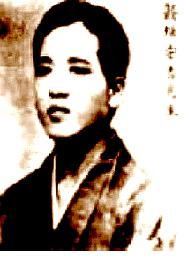 |
Ankichi Arakaki
The first of 11 children, Ankichi Arakaki was born in November 1899, in Akata Village, Shuri. His family were sake (rice wine) brewers and, as such, enjoyed a comfortable lifestyle and eventually moved to Tori-hori Village.
Sensei Arakaki commenced his karate training at an early age, learning from Shinpan Gusukuma (his primary school teacher) and also Chomo Hanashiro (his junior high school teacher), before leaving school and intensifying his training under Chosin Chibana (founder of Kobayashi Shorin-ryu).
It was because of the wealth that his family enjoyed that Arakaki was able to devote a great deal of time to his training, and soon became very proficient, earning the nickname of 'Uwayaguwa Ankichi' (Ankichi of Uwayaguwa). His specialty was the development of the toe kick or tsumasaki-geri.
One story tells of the devastating effect of Arakaki's toe kick:
|
|
Once, when Sensei was around twenty years old, he and some friends were in a tea house in Tsuji drinking and having a good time. While getting up to go to the toilet, he accidentally bumped into a big man who insisted on picking a quarrel with him in the corridor on the second floor. Trying to ignore the man, Sensei was unable to get out of his way, which resulted in Sensei being shoved down the staircase. Being in such good physical condition, Arakaki was able to roll down the stairs avoiding injury. The enraged man leaped down the stairs and grabbed Arakaki by the arm, trying to yank him up in an effort to punch his face. Seizing the man's arm with the other hand, Sensei drove his toes deeply into the armpit of his attacker, which resulted in the man dropping to the ground unconscious.
Needless to say, Sensei never returned to that tea house again. About six months later, while reading the newspaper one morning, Ankichi was shocked to see a story which described some big wrestler who had died as a result of injuries sustained by "some karate expert" at a tea house in Tsuji. The article went on to say that "survived by two daughters, both of whom were serious judoka, the family sought to revenge the death of their beloved father". In spite of the man allegedly dying sometime after his encounter with Arakaki, the police were never called in, and a subsequent investigation was unable to provide the actual reason for his death.
Around 1921, after discharge from his military service, he moved to the village of Kadena. Unfortunately, due to the fact that his father had died and the family business was profoundly affected by the recession which followed World War 1, Sensei Ankichi Arakaki contracted stomach ulcers and died on 28th December 1927. He was just 28 years old.
|
|
|
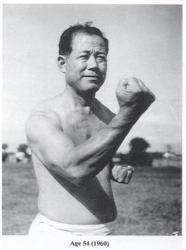 |
 |
Shōshin Nagamine (長嶺 将真)
Shōshin Nagamine (Nagamine Shōshin 1907-07-15–1997-11-02) was a Japanese author, soldier, police officer and karate master.
Nagamine was born in Tomari, in Naha City, Okinawa. He was a small and
sickly child, and he contracted a gastroenteric disorder in 1926, his second
year of high school. He began a self-imposed diet and took up karate under
the watchful eye of his next-door neighbour, Chojin Kuba. Nagamine soon
became a picture of good health, crediting his recovery to "hard work
both at school and training of Karate". His health improved to such
an extent that he became a leader of the school's karate club, and his
friends dubbed him Chaippaii Matsu, a nickname meaning "tenacious
pine tree
After graduation in March 1928, he began to study martial arts full time,
moving to Shuri and training under Taro Shimabuku
|
(島袋善良) and Ankichi Arakaki. Later that year, he was conscripted into the
Japanese army in the 47th Infantry Division, and fought in China before
receiving an honourable discharge in 1931.Leaving the army, Nagamine sought
an area in which his martial arts abilities would be useful, eventually
settling on the police force
During his time as a police officer, Nagamine received further instruction
in karate from Chotoku Kyan and Motobu Choki, and achieved the title of
Renshi in 1940. By 1951, Nagamine was a Police Superintendent, of Motobu,
and was training his own officers in karate.
Matsubayashi-ryū (松林流), is a style of Okinawan karate that was founded in 1947 by Shōshin Nagamine
(1907–1997). Its curriculum includes 18 kata, 7 two-man yakusoku kumite
(prearranged sparring) routines, and kobudō (weapons) practice. Matsubayashi-ryu
is one of the four main styles of karate on Okinawa today, and was one
of the styles represented when the Okinawa Karate-do Federation was founded.
It included the styles: Goju-ryu, Uechi-ryu, Shorin-ryu, and Matsubayashi-ryu.
Sensei Nagamine named his style in honor of the two masters whom he viewed
as the most important masters that his teachings were based upon, Sōkon
Matsumura of Shuri-te and Kosaku Matsumora of Tomari-te. He chose to name the school using the first kanji characters from both master's names Matsu (松) and the style is pronounced in Japanese "Matsubayashi".
Shuri-te is divided into three styles, two are called Shorin-Ryu and a
third is called Matsubayashi-Ryu.
Matsubayashi-Ryu is a style of Shorin-Ryu and the terms Matsubayashi-Ryu and
Shorin-Ryu can be used interchangeably. Normally, the style is referred to as Shorin-Ryu but when a definite
distinction is required between the other styles of the Shorin family (Kobayashi-Ryu
& Shobayashi-Ryu) then it is called Matsubayashi-Ryu.
Nagamine Shōshin also credited Motobu Chōki as the teacher who inspired
his seven Yakusoku kumite forms. Today, the official Matsubayashi-ryū organization
is run by Shōshin Nagamine's son, Takayoshi Nagamine, though there are
many schools teaching Matsubayashi-ryū that are not officially affiliated
with the Nagamine dojo. A new kata, Fukyugata San, was developed in 1960
by Ueshiro sensei and is performed in his association's schools.
Matsubayashi-ryū is one of the better-documented traditional karate styles,
owing to Nagamine's book, The Essence of Okinawan Karate-dō. as well as Tales of Okinawa's Great Masters.
|
|
|
 |
 |
Zenryo Shimabukuro (島袋 善良)
Zenryo Shimabukuro (Shimabukuro Zenryō 14 November 1908 - 14 October 1969) was a karate master and the founder of Shorin-ryu Seibukan karate.
Zenryo Shimabukuro was born in Shuri, Okinawa in 1908. He earned his living
as a baker and tatami maker, but had studied karate under the karate master
Chotoku Kyan. He began his training with Kyan in 1932, but trained with
him until Kyan's death in 1945, excluding the years during World War II,
when karate instruction had ceased.
Following World War II, Shimabukuro opened his own dojo, teaching karate
out of his home. His students included his son Zenpo Shimabukuro and his
nephew Zenji Shimabukuro, each of whom became karate masters in their own
right. One of his early students was an American paratrooper named William
Fuller Jr., who arranged for Shimabukuro to teach karate to some of the
other American paratroopers stationed in Okinawa.
|
|
In 1960, he became president of the Okinawan branch of the Japan Karate-do
Federation/All-Japan Karate-do Federation, though the branch later withdrew
and became the Okinawan Karate-do United Association. In 1962, Shimabukuro
founded his school, which he named Seibukan (meaning Holy Art School).
In 1964 he was awarded a 10th dan red belt, which is the highest rank available
within the Okinawan Karate-do United Association.
In 1967, the Okinawan Karate-do United Association became the All-Okinawan Karate-do Federation, with Shimabukuro continuing to serve as the organization's
vice president.On October 14, 1969, Zenryo Shimabukuro died of appendicitis.
His son Zenpo Shimabukuro became the master of the school his father had
founded, Seibukan.
|
|
|
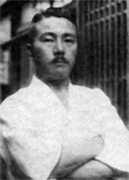 |
 |
Yasuhiro Konish
Shindō jinen-ryū (神道自然流, Shindō jinen-ryū) is one of the six original karate schools, or ryū, recognized by the DNBK
in the early 1930s. The system was founded by Yasuhiro Konishi, a practitioner
of Shindo Yoshin-ryū Jujutsu who trained with many of the first Okinawans
to teach karate in Japan. Konishi trained with Gichin Funakoshi (founder
of Shotokan), Kenwa Mabuni (founder of Shitō-ryū), Chōjun Miyagi (co-founder
of Gōjū-ryū), legendary fighter and teacher Motobu Chōki, and Morihei Ueshiba
(founder of Aikido).Konishi's organization, Japan Karate-dō Ryobu-Kai,
has spread worldwide, with branches in more than 20 countries under the
leadership of Yasuhiro (Takehiro) Konishi, 10th dan, and the guidance of
Kiyoshi Yamazaki, 8th dan, International Director and Chief Instructor.
Shindō Jinen-ryū draws heavily from both Shotokan and Shitō-ryū but also
extensively utilizes aikido, jujutsu, and kendo principles and techniques,
reflecting the founder's background. Japan Karate-dō Ryobu-Kai is the only
organization associated with the six original styles of karate that has
never experienced an internal schism, and it remains the sole unifying
body for Shindō Jinen-ryū Karate-dō. |
|
|
| Reference :Wikipedia |
    |
| JAPAN KARATE DO HAKUA-KAI MATSUBUSHI DOJO |









